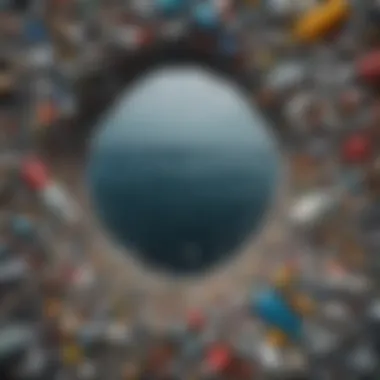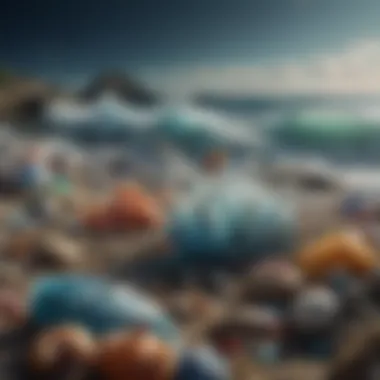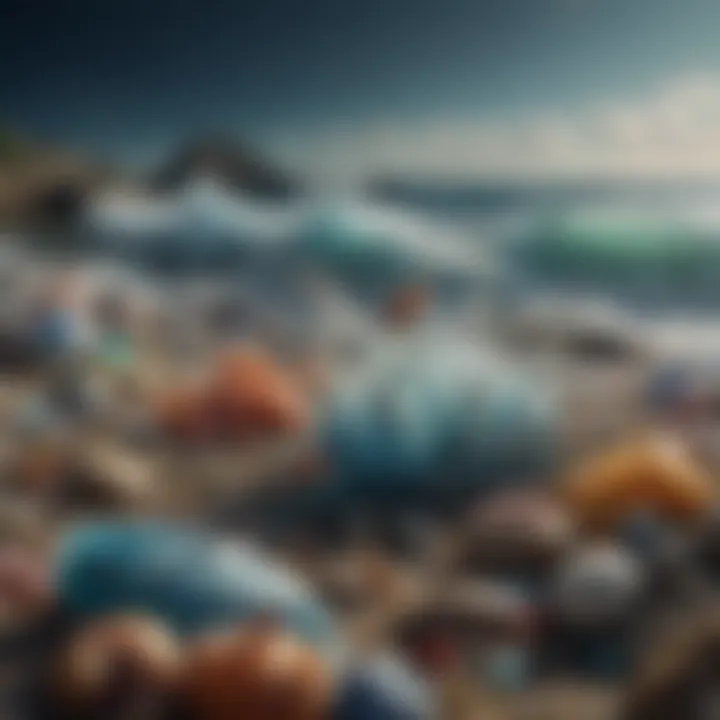The Alarming Impact of 8 Million Tons of Plastic in Oceans


Intro
Plastic pollution in the oceans has reached a critical point. Every year, approximately 8 million tons of plastic find their way into marine ecosystems. This troubling statistic raises pressing questions about our environmental practices and the future of marine life. Understanding the various sources and consequences of this phenomenon is essential for informed action and effective solutions.
Research Overview
Key Findings
The research on plastic pollution reveals alarming insights. Over half of the plastic waste entering the oceans stems from poorly managed waste. Urban areas lack adequate disposal systems, leading to increased runoff of plastic debris into waterways. Besides, it is estimated that by 2050, there could be more plastic than fish in the ocean by weight if current trends continue. Moreover, various species, including fish and seabirds, increasingly consume microplastics mistaken for food.
Study Methodology
Research is conducted through a combination of scientific field studies, laboratory experiments, and data collection from global ocean surveys. Researchers often collaborate with environmental organizations to monitor plastic distribution across oceanic regions. Advanced technologies like satellite imaging and underwater drones also aid in tracking plastic concentrations. This multifaceted approach allows for a comprehensive understanding of plastic pollution.
Background and Context
Historical Background
Plastic production began in the early 20th century, but it escalated significantly in the decades that followed. The convenience of plastic made it a popular material for packaging and consumer goods. However, its persistence in the environment became evident by the end of the 20th century. Initiatives to tackle this issue emerged, but they have not kept pace with the problem's scale.
Current Trends in the Field
Current trends show a growing awareness of plastic pollution. Many countries are implementing bans on single-use plastics, and organizations are promoting recycling programs. Additionally, scientific research on the effects of plastic on marine life is intensifying. The collaboration among governments, scientists, and the public is crucial to mitigating this pressing issue.
"Every year, millions of tons of plastic are discarded thoughtlessly, wreaking havoc on marine ecosystems and posing risks to human health."
The need for immediate action has never been more apparent, and understanding these key trends is essential for effective policy development.
Foreword to Marine Plastic Pollution
Plastic pollution in marine environments presents an urgent environmental challenge. It affects not only marine ecosystems but also human health, economies, and social structures. Understanding marine plastic pollution encompasses recognizing the sources from which plastic enters the ocean and the broad implications associated with its accumulation.
Marine plastic pollution is not just a statistical issue; it embodies concerns related to biodiversity, economic stability, and public health. This article explores these elements, focusing on the staggering figure of 8 million tons of plastic entering the ocean annually. Grasping this scale pushes us to analyze the factors contributing to this crisis and what can be done to mitigate it.
Understanding the Scale of the Problem
The scale of marine plastic pollution is difficult to comprehend fully. Each year, millions of tons of plastic waste make their way into oceans worldwide. This influx primarily comes from two main sources: land-based and ocean-based activities. Factors include urban runoff, littering, improper waste disposal, as well as fishing and shipping industries contributing to the crisis. This pervasive issue manifests itself in various forms, such as microplastics, discarded fishing nets, and plastics from consumer products.
According to recent estimates, approximately 80% of marine debris originates on land. This statistic underscores the importance of waste management practices and their effectiveness. In areas where waste management systems are inadequate, plastic waste often finds its way into waterways and eventually oceans.
The Million Tons Statistic Explained
The figure of 8 million tons of plastic entering the oceans each year represents a significant and alarming reality. This number derives from various research studies assessing the global waste generation and plastic leakage into marine environments. This volume is equal to dumping a garbage truck full of plastic into the ocean every minute.
The implications of this statistic are vast. Marine animals are known to ingest or become entangled in plastic debris, leading to injury or death. Furthermore, plastics can break down into microplastics, which can be ingested by even the smallest organisms in the marine food web. The potential consequences ripple up the food chain, affecting larger marine species and ultimately implicating human beings who consume seafood.
"If the current trends continue, the weight of plastic in the ocean will surpass that of fish by 2050." This alarming prediction illustrates the urgency to address the plastic crisis.
This introduction sets the groundwork for exploring further dimensions of plastic pollution in the ocean, emphasizing the necessity for awareness and action to combat this pressing issue.
Sources of Plastic in the Ocean
Understanding the sources of plastic in the ocean is critical for forming effective strategies to combat marine pollution. Each contributor plays a distinct role in generating the 8 million tons of plastic that enter oceans every year. Identifying these sources helps in addressing the issue systematically. By examining both land-based and ocean-based contributions, along with the efficiency of waste management systems, we can create a focused framework for mitigating this environmental crisis.
Land-Based Contributions
Land-based contributions are the predominant source of plastic in the ocean. Most plastic originates from urban areas where waste management is inadequate or ineffective. Disposable plastics, like bags and bottles, are commonly used but poorly managed after their lifespan. When plastic products are littered or improperly disposed of, they can easily find their way into waterways and eventually reach the ocean.
Factors influencing land-based contributions include:
- Population Density: Areas with high populations produce a significant amount of waste.
- Consumerism: Increased consumption of convenience products leads to higher plastic usage.
- Waste Management Practices: Poorly designed systems fail to effectively process and recycle plastic waste.
Many countries struggle with solid waste management, especially in developing regions. When local infrastructures cannot cope, plastics often end up in the environment. Achieving improvement in this area will require investment in infrastructure and the promotion of recycling policies.


Ocean-Based Contributions
While land-based sources dominate, ocean-based contributions cannot be overlooked. These involve plastic waste generated directly from activities at sea, such as fishing, shipping, and tourism. The following elements contribute significantly to ocean-based plastic pollution:
- Fishing Gear: Lost or discarded fishing nets and gear create substantial marine debris, often referred to as "ghost gear.”
- Shipping and Maritime Industries: Cargo ships and cruise liners can inadvertently discharge plastic waste, including packaging materials.
- Marine Tourism: Touristic activities can lead to littering, especially in coastal areas.
Measures must be taken to regulate fishing and shipping activities, ensuring proper disposal of waste at sea. Advocates call for stricter laws and awareness campaigns to reduce the impact of these practices on marine environments.
Role of Waste Management Systems
The effectiveness of waste management systems plays a crucial role in determining how much plastic ends up in the ocean. Comprehensive and efficient waste management can significantly reduce the amount of plastic in marine ecosystems. However, various challenges hinder progress:
- Inadequate Facilities: Many regions lack the resources to manage waste properly.
- Low Recycling Rates: Often, a small percentage of plastic waste is actually recycled.
- Public Awareness: Lack of education about recycling practices leads to improper disposal.
Investing in innovative waste management systems can have a positive impact. Improvement in recycling technologies and public awareness initiatives are essential steps toward ensuring that plastics do not reach oceans.
"Understanding the sources is the first step to combat marine plastic pollution effectively."
To conclude, recognizing the diverse sources of plastic waste reveals the complexity of this issue. It is a multifaceted problem that requires coordinated efforts from individuals, industries, and governments alike. Solving the plastic crisis in our oceans demands that we examine and enhance all aspects of waste management and prevent further contributions from land and sea.
Ecological Consequences of Plastic Pollution
The ecological consequences of plastic pollution represent a crucial element of understanding how pervasive plastic waste affects marine environments. Every year, an estimated 8 million tons of plastic enter the oceans, disrupting natural systems and affecting various forms of life. The depth of this issue goes beyond simple visibility; it fundamentally alters ecosystems, compromises biodiversity, and poses substantial risks to marine species.
Impact on Marine Biodiversity
Marine biodiversity is heavily impacted by plastic pollution. Species encounter various types of plastics, from large pieces that can entangle marine animals to microplastics that are consumed by smaller organisms. Marine mammals, fish, and birds can be particularly vulnerable.
- Entanglement: Larger plastics, like fishing nets and bags, pose a physical danger. Many marine creatures get trapped, leading to injury or death.
- Ingestion: Smaller creatures, including plankton and fish, mistake microplastics for food. Consuming these particles can disrupt their digestive systems and lead to starvation.
For example, sea turtles often ingest plastic bags, thinking they are jellyfish, which can obstruct their intestines, ultimately threatening their survival. Overall, plastic pollution exacerbates the risk of extinction for many species.
Effects on Marine Food Chains
The relationship between plastic pollution and marine food chains is significant. The introduction of plastic into these systems can have cascading effects on all levels of the food web. Of particular concern are:
- Bioaccumulation: Plastics often attract harmful chemicals from the water, such as pesticides and heavy metals. When small organisms consume these plastics, toxins accumulate in their bodies. This, in turn, affects larger predators, including fish and marine mammals, disrupting reproductive and growth processes.
- Alteration of prey availability: With changes in biodiversity, some species may decline while others increase, leading to imbalances. A decline in fish populations due to pollution can hurt species that rely on fish as a primary food source.
As these changes unfold, the ecological balance is undermined, impacting productivity and diversity in marine ecosystems.
Microplastics and Their Implications
Microplastics, particles less than five millimeters in size, have become a significant concern due to their widespread distribution in the oceans. Their implications can be profound:
- Ecosystem Dynamics: Microplastics can change the behaviors of marine species. For instance, fish exposed to microplastic contamination may exhibit altered feeding behaviors, affecting the patterns of predator and prey.
- Human Concerns: There is growing concern over the potential for microplastics to enter the human food supply through seafood consumption. Research is ongoing about how these contaminants may affect human health.
"Understanding the intricate connections within marine ecosystems is vital, as even small disruptions can lead to significant consequences for the entire environment."
To delve deeper into the marine ecosystems and conservation efforts, explore resources like Wikipedia and Britannica.
- Understanding these complex interactions is a critical step towards effective solutions for marine plastic pollution.
- Engaging in local and global efforts can significantly reduce the overall impact of plastic waste.
Economic Implications of Plastic Pollution
The economic implications of plastic pollution are extensive and complex. Understanding these implications is crucial for various stakeholders, including governments, businesses, and communities directly affected by marine pollution. Plastic waste not only poses environmental challenges but also imposes severe financial burdens across multiple sectors. This section examines the significant areas impacted by plastic pollution: fisheries, tourism, and policy implementation.
Cost to Fisheries and Aquaculture
The fishing industry is one of the sectors most affected by plastic pollution in the oceans. Fishermen often encounter plastic debris in their nets, leading to damaged gear and increased operational costs. Moreover, plastics can harm marine life, causing declines in fish populations vital for both commercial and recreational fishing.
Impacts include:
- Decreased Fish Populations: Fish ingest plastic or become entangled, affecting their survival rates.
- Reduced Livelihoods: Loss of income for fishermen due to decreased catch leads to economic hardship in coastal communities.
- Increased Cleanup Costs: Fisheries must allocate resources for cleanup, taking away funds from other investments.
- Economic Disruption: Disruption in fish supply affects not only local economies but also larger markets dependent on seafood products.
Impact on Tourism and Coastal Communities


Tourism is a significant source of revenue for numerous coastal communities. However, the presence of plastic pollution detracts from the natural beauty of beaches and oceans, leading to negative perceptions among tourists. This can result in decreased tourist numbers and reduced income for businesses reliant on tourism.
- Beaches and Attractions: Polluted beaches repel visitors, directly affecting hotels, restaurants, and recreational services.
- Economic Downturn: Local economies suffer when tourism declines, leading to job losses and increased unemployment.
- Clean-Up Efforts: Coastal communities must invest in cleanup and restoration, diverting funds from crucial services.
The impact of plastic pollution on tourism can be profound. It not only affects immediate revenue but also long-term perceptions and sustainability in coastal areas.
Trade-offs in Policy Implementation
Addressing plastic pollution involves complex policy decisions. Implementing effective policies to reduce plastic waste must be balanced with economic considerations. Policymakers face trade-offs that can significantly impact local economies.
- Regulatory Measures: Stricter regulations may increase operational costs for industries, leading to potential job losses.
- Investment in Alternatives: Transitioning to sustainable materials often requires initial investment, which may be a challenge for small businesses.
- Public Awareness Campaigns: These require funding and resources that may strain local budgets. However, effective campaigns can promote behavior change, ultimately benefiting the economy in the long run.
Balancing environmental welfare with economic resilience is necessary for sustainable development. Policymakers should consider the repercussions of their actions on various sectors and involve community input in decision-making processes.
Human Health Concerns Related to Plastic Pollution
The significant presence of plastic in marine environments poses dire risks not only to marine ecosystems but also to human health. Understanding these human health concerns is vital, as the links between plastic pollution and health issues become increasingly evident. The consumption of marine animals contaminated with plastics has implications that extend beyond the ocean, affecting communities around the world. Consequently, addressing these health risks deserves attention within the broader framework of environmental conservation.
Contaminants in the Marine Food Chain
Marine food chains are complex networks connecting various organisms, from tiny plankton to larger predators such as fish and mammals. When plastics break down into smaller pieces, known as microplastics, they can absorb toxic substances from the surrounding water. Chemicals such as polychlorinated biphenyls (PCBs) and heavy metals can attach to these particles, which marine organisms may subsequently ingest. This process compromises the quality of seafood consumed by humans.
The concerns regarding contaminants in the food chain underscore the potential health risks. Studies have shown that higher concentrations of such contaminants found in fish and shellfish could lead to various health problems, including:
- Endocrine disruption: Chemicals may interfere with hormone systems, adversely affecting reproductive health.
- Carcinogenic effects: Persistent organic pollutants have been linked to increased cancer risks in humans after long-term exposure.
- Neurological effects: Heavy metals like mercury can adversely impact cognitive function.
Continuous monitoring of contaminant levels in marine species is crucial to mitigate these risks for public health.
Potential Risks from Microplastics
Microplastics pose unique challenges to human health. These tiny plastic fragments, often less than five millimeters in size, have infiltrated ecosystems globally. Their prevalence means that they can enter human bodies through various pathways, primarily via diet and possibly through drinking water. Early research suggests several potential health risks associated with microplastics, which merit further investigation:
- Inflammation: Some studies indicate that microplastics can cause chronic inflammation in tissues.
- Immune response: The presence of foreign substances in the body can provoke an immune response, leading to potential allergic reactions.
- Bioaccumulation: The risk of microplastics accumulating in human organs raises concerns about long-term health effects.
Furthermore, the breakdown of plastic in the marine environment may release harmful additives, introducing additional complexities to the potential health impacts of microplastics on humans.
The increasing understanding of human health implications linked to marine plastic pollution calls attention to the need for decisive actions to address the crisis.
In summary, the health concerns surrounding plastic pollution extend beyond environmental degradation. As we learn more about contaminants in the marine food chain and the risks posed by microplastics, it becomes essential to integrate public health considerations into efforts aimed at combating plastic pollution.
Current Initiatives and Policies Addressing Plastic Pollution
The issue of plastic pollution in marine environments requires significant effort from multiple entities. This section explores the various initiatives and policies created to combat this pressing problem. These efforts can take many forms and often involve national governments, international agreements, non-government organizations, and the collective responsibility of individuals. Tackling plastic pollution is not just about fixing a problem; it is about changing mindsets and systems to create a sustainable future.
Legislation at National and International Levels
Legislation is a key aspect of addressing plastic pollution. Various countries have passed laws to limit plastic production and use. For instance, several nations have enacted bans on single-use plastics, such as straws, bags, and cutlery. These laws aim to shift consumer behavior and encourage the use of alternatives. Many countries, such as France and Canada, have committed to phasing out certain plastics altogether.
"Addressing plastic pollution is a collective responsibility that spans across nations and requires a unified approach."
Internationally, treaties, such as the Basel Convention, facilitate the control of plastic waste trade. New discussions are underway for a binding global agreement to control plastic pollution. This is essential. A unified international policy can help close regulatory loopholes and ensure that all countries act in the best interests of marine environments.
Innovative Solutions and Technologies
Innovation plays a critical role in combating plastic pollution. New technologies are emerging that aim to reduce, recycle, or eliminate plastics. For example, some startups are working on biodegradable alternatives to traditional plastics. These options can help minimize the long-term impact of plastic on the environment.
Also, there are advances in cleaning technology, such as autonomous drones and specialized boats designed to collect plastic debris from oceans. The Ocean Cleanup project, for instance, employs advanced methods to remove large quantities of plastic from the Great Pacific Garbage Patch.
Furthermore, research continues on recycling technology. Processes like chemical recycling can convert plastic back into its original monomers, which can then be reused to create new plastic products. This reduces the dependency on virgin plastics and lessens environmental impact.
Community Engagement and Education
Community involvement is essential in the fight against plastic pollution. Local initiatives can have a significant impact. Educational campaigns help raise awareness about the consequences of plastic waste. They encourage the community to adopt more sustainable practices.
Group efforts like beach cleanups foster a sense of responsibility. When individuals participate, they not only clean their local areas but also inspire others to act. Schools and organizations often partake in these initiatives, further spreading awareness and understanding.


Social media plays a crucial role. Platforms such as Facebook and Reddit host discussions and promote events focused on reducing plastic waste. Engaging the public through education and active participation creates a network of informed individuals who are crucial for the success of initiatives aimed at reducing plastic pollution.
The Role of Individuals in Combatting Plastic Pollution
Addressing plastic pollution requires collective efforts on multiple fronts. However, the role of individuals is crucial in creating change at the grassroots level. Each person's actions can ripple outwards, leading to significant outcomes in the fight against plastic pollution. Individual choices regarding consumption, disposal, and advocacy matter. As awareness rises, it becomes evident that personal responsibility can align with broader policies and initiatives aimed at protecting marine ecosystems.
Reducing Personal Plastic Footprint
Reducing one’s plastic footprint entails conscious decisions about daily habits. Individuals can take several actionable steps to minimize plastic use:
- Opt for Reusable Products: This includes using cloth bags instead of plastic ones, stainless steel or glass water bottles, and avoiding plastic straws.
- Choose Minimal Packaging: Selecting products with less packaging or buying in bulk helps limit the amount of plastic waste generated.
- Practice Responsible Disposal: Educating oneself on proper recycling methods is important. Misplaced plastics often end up in landfills or oceans.
- Support Local and Eco-Friendly Brands: When possible, purchase from companies that prioritize sustainable materials in their packaging.
By making these changes, individuals can quickly decrease the amount of plastic that contributes to ocean pollution. The impact of individual actions should not be underestimated, as these small shifts in behavior can add up to more substantial environmental benefits.
Promoting Sustainable Practices
Promoting sustainable practices goes beyond personal choices. It involves encouraging communities, schools, and workplaces to adopt environmentally friendly routines. Some effective measures include:
- Organize Clean-Up Initiatives: Local community clean-ups can engage people and raise awareness of plastic pollution. These events foster community spirit and highlight the importance of keeping environments clean.
- Educate Others: Sharing knowledge about the effects of plastic pollution can spur more informed choices. Workshops, social media campaigns, and local events can raise awareness on a larger scale.
- Advocate for Policy Changes: Individuals can participate in campaigns to push for more robust regulations regarding single-use plastics and waste management.
- Cultivate a Culture of Recycling: Encouraging proper recycling habits within circles can foster responsibility. This can involve setting up recycling stations or providing resources on the recycling process.
Through advocacy and education, individuals can influence broader societal norms, integrating sustainable practices into everyday life. By becoming active participants in the movement against plastic pollution, they support not just their own environment but also contribute favorably to global efforts.
“The collective impact of individuals can lead to profound change, as small actions accumulate to challenge the status quo.”
Future Directions in Plastic Pollution Research
The ongoing crisis of plastic pollution in oceans necessitates continuous research and adaptation. Future directions in this field are crucial for formulating effective strategies to combat and mitigate the impacts of marine plastic waste. This research is vital, not only for understanding the dynamics of plastic pollution but also for informing policies and fostering technology development. Emphasis on these areas can lead to innovative solutions that can change the current trajectory of plastic waste accumulation.
Emerging Techniques in Monitoring and Cleanup
Monitoring plastic pollution is becoming increasingly sophisticated. Innovative technologies play a central role in tracking and managing plastic waste in marine environments. For instance, remote sensing and satellite imagery can map areas most affected by pollution. These techniques help researchers understand the movement and accumulation of plastics over vast ocean areas.
Moreover, advancements in drone technology allow for more precise collection of plastic debris in hard-to-reach coastal regions. Increasingly, autonomous underwater vehicles (AUVs) are being designed to survey deep oceans and identify plastic hotspots. Collectively, these emerging techniques improve data collection, which is essential for developing effective cleanup operations.
Cleanup efforts themselves are evolving as well. Systems like the Ocean Cleanup project utilize barriers and collection systems to trap and remove plastic from the water. Such projects are essential to remove existing pollution while new strategies must focus on preventing plastic from reaching the ocean in the first place. These combined efforts show promise in tackling the problem on multiple fronts.
Collaborative Approaches to Addressing Marine Pollution
Addressing the issue of marine plastic pollution requires collaboration across various sectors. This includes governmental bodies, non-profit organizations, and research institutions. Partnerships can lead to sharing knowledge, resources, and innovation. Collaborative research can further aid in understanding the long-term effects of plastics on marine ecosystems, helping to formulate effective regulations.
International cooperation is especially important. The ocean knows no borders, and plastic pollution does not respect nationalities. Initiatives that encourage countries to work together can drive comprehensive approaches to waste management. For example, policies like the Global Plastics Treaty aim to create a unified regulatory framework to moderate plastic production and disposal worldwide.
In addition, local communities play a critical role. Engaging with local stakeholders ensures that initiatives are tailored to specific regions, considering local environmental and economic contexts. This can motivate individuals to participate in local cleanup activities or reduce plastic usage in their daily lives.
"Effective strategies to combat plastic pollution will emerge from a convergence of technology, research, and collaboration between all stakeholders involved."
Ending: Confronting the Crisis of Plastic Pollution
The examination of plastic pollution in our oceans presents an urgent situation. The staggering figure of 8 million tons of plastic entering marine environments each year highlights a crisis that can no longer be overlooked. This conclusion synthesizes the critical insights gained from explorations of sources, ecological impacts, economic implications, and the significant health risks associated with plastic pollution. Understanding these dimensions deepens our appreciation for the vast complexities involved and forewarns us of the consequences if we do not take decisive action.
As discussed previously, the sources of plastic are varied, ranging from land-based waste management failures to oceanic waste from industries. Each source adds to a growing, dire situation. The diverse ways plastic interacts with marine life demonstrate not only the ecological consequences but also the economic repercussions, notably in sectors such as fisheries and tourism. The potential risks to human health, particularly through the food chain, further amplify the need for awareness and action.
Key insights reveal that this is not just an environmental issue but one that requires multi-faceted solutions involving policy, technology, and individual behaviors. Addressing plastic pollution calls for comprehensive strategies that require cooperation among governments, industries, and civil society. Only through coordinated efforts can we hope to tackle this multifaceted challenge effectively.
Additionally, various initiatives and policies have emerged to combat this pollution problem, highlighting the importance of legislation and community engagement. Every effort, no matter how small, contributes to the collective fight against the insidious spread of plastics in our oceans.
"To confront the crisis of plastic pollution, we must act not only with urgency but also with innovation, collaboration, and dedication."
Summarizing Key Insights
The key takeaways from this discourse on plastic pollution can be summarized as follows:
- Scale of the issue: Every year, 8 million tons of plastic enter the ocean, posing significant threats to marine ecosystems.
- Diverse sources: Plastic waste comes from a myriad of land and ocean-based activities, with ineffective waste management being a prime contributor.
- Ecological consequences: Marine biodiversity suffers due to ingestion and entanglement in plastic, disrupting food chains and threatening species survival.
- Economic implications: The industries reliant on healthy marine environments face significant economic strains due to pollution-related damages.
- Public health concerns: The potential health risks associated with consuming contaminated seafood demand public awareness and monitoring.
Call to Action for Informed Responses
The call to action is clear; informed responses are necessary at every level. Here are specific actions individuals, organizations, and governments can take:
- Reduce plastic use: Engaging in personal behaviors that diminish reliance on single-use plastics significantly contributes to reducing overall plastic waste.
- Support innovation: Supporting technologies and businesses that focus on sustainable materials enhances a collective effort toward sustainability.
- Advocate for policy change: Individuals should encourage policymakers to implement effective legislation that addresses plastic use and fosters recycling initiatives.
- Educate others: Raising awareness about the impacts of plastic pollution can lead to broader efforts at community and societal levels.
- Participate in clean-up efforts: Involvement in local clean-up initiatives fosters community engagement and visibly reduces plastic in immediate environments.
By addressing plastic pollution head-on, society can mitigate the ongoing dangers to the ocean, safeguard ecosystems, and ultimately protect human health and economic viability for generations to come.







